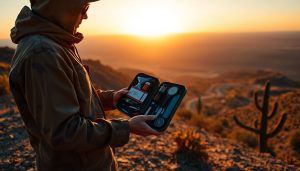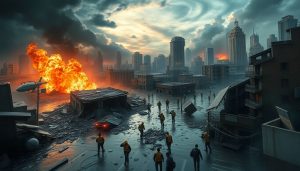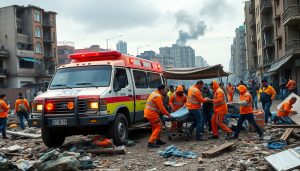In short: Natural disasters come suddenly, take lives, and lead to economic damage. Due to global warming, some disasters are now more frequent and intense. Knowing the range of natural disasters makes preparedness more practical. Being informed can save lives and reduce damage.
What are Natural Disasters? An Overview
Natural disasters are violent events caused by nature, not humans. Examples include earthquakes, floods, and hurricanes. These disasters can harm people, destroy homes, damage infrastructure, and affect ecosystems. They result from geographical, climatic, and environmental factors.
Types of Natural Disasters
Earthquakes and Seismic Activities
Earthquakes are sudden ground shaking due to tectonic plate movements. They can cause tsunamis and destroy buildings. The 2011 Japan earthquake is a notable example. While hard to predict, early warning systems and safety measures like strong building designs and drills can reduce risk.
Flood
Flooding occurs when land is submerged by water from rain, storms, or melting snow. Coastal, inland, and flash floods are common worldwide. The 2010 Pakistan floods were especially severe. Use flood barriers, monitor alerts, and plan with your community to prepare.
Hurricanes, Typhoons, and Tropical Cyclones
These storms bring storm surges and high winds to tropical areas. Warm ocean waters fuel them. Hurricane Katrina in 2005 caused major destruction in New Orleans. Climate change is intensifying these storms. Have evacuation plans, fortify property, and follow forecasts.
Wildfires
Wildfires spread rapidly through forests and can reach urban areas. They often start from lightning, human activity, or drought. The 2019–2020 Australian bushfires were catastrophic. Fire breaks, controlled burns, and community fire safety education are key to prevention.
Volcanic Eruptions
Volcanoes erupt when magma reaches the surface, releasing ash and gases. Examples include Mount Vesuvius in AD 79 and Mount St. Helens in 1980. Experts monitor volcanoes to predict eruptions. Evacuation plans, ash masks, and alerts are vital precautions.
Tsunamis
Tsunamis are massive ocean waves caused mostly by underwater earthquakes. The 2004 Indian Ocean tsunami killed over 200,000 people. Warning systems help save lives. Coastal residents should know evacuation routes and practice safety drills.
Other Notable Natural Disasters
- Landslides and Mudslides: Triggered by rain, earthquakes, or volcanoes. The 2018 Kerala floods included deadly landslides.
- Droughts: Long dry periods cause water shortages and crop failure. California’s 2012–2017 drought hit agriculture hard.
- Extreme Weather: Includes tornadoes, hailstorms, and blizzards. Tornado Alley in the US sees some of the most intense tornadoes.
Disaster Preparedness
Awareness and early warnings save lives. Strong infrastructure, emergency kits, and family safety plans are essential. Communities should practice drills and share information. Real-time alerts from technology help improve readiness.
Conclusion
Natural disasters come in many forms with unique causes and effects. Understanding them improves preparedness. Staying informed, planning ahead, and acting early can protect lives. Working together gives us the best chance to reduce risk. Preparedness is the key to survival.




